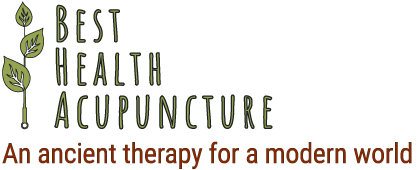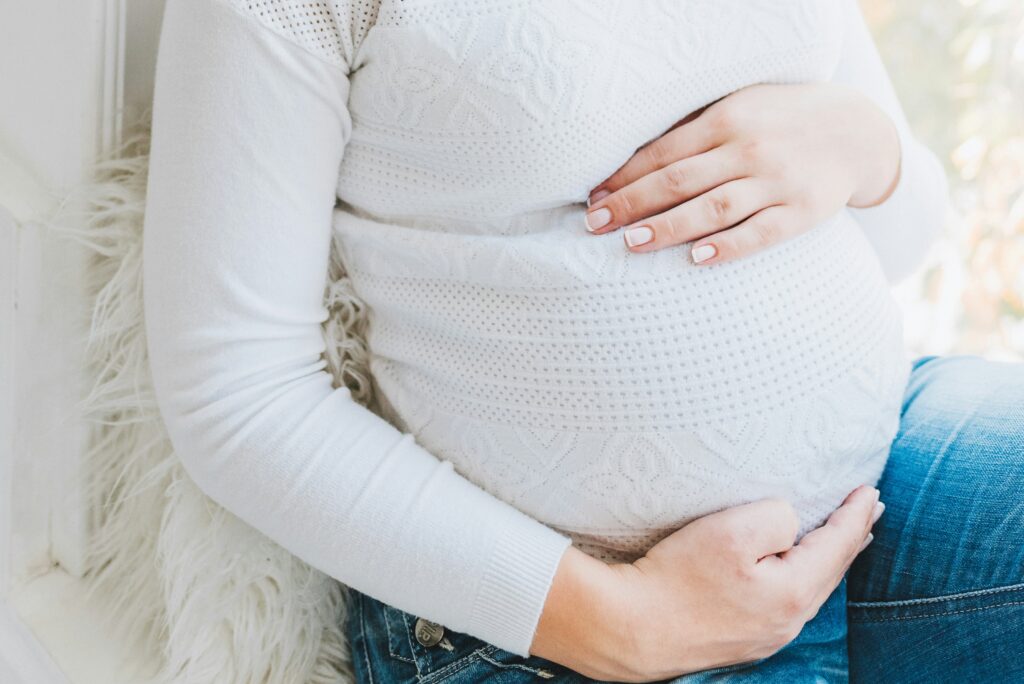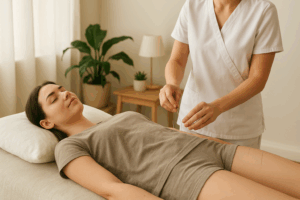Pregnancy is a time of profound changes and your body’s primary job is to nurture and protect the life growing within you. One way to promote a healthy pregnancy and ensure the best possible start for your baby is by minimizing exposure to toxins—chemicals found in everyday products that can affect both you and your developing child. Reducing toxin exposure is equally important during the postpartum period, especially if you’re breastfeeding. The biggest sources of toxins are found in consumer products, the environment and our food supply. Here’s how to protect yourself and your baby from harmful chemicals:
1. Be Mindful of Food Choices
What you eat plays a major role in your overall health and the health of your baby. During pregnancy, it’s crucial to avoid toxins that can be present in food. Here are some steps to follow:
- Choose organic when possible: Pesticides used in conventional farming may linger on fruits and vegetables. Opt for organic produce when possible. Glyphosate (aka Round Up by Monsato) is a suspected human carcinogen and affects DNA and genetic expression in offspring. Although glyphosate has been banned or restricted in many communities, it is still widely used in some parts of Canada. All oats are full of glyphosate unless they are organic. Cheerios and oatmeal are often served to young children under the guise they are healthy, but they are filled with glyphosate and the organic alternative should always be purchased with these products.
- Familiarize yourself with the Dirty Dozen and Clean 15: The Dirty Dozen is a list published yearly by the EWG of the top 12 foods that contain the most pesticides. These foods should always be purchased organic: strawberries, spinach, kale, grapes, peaches, nectarines, apples, bell and hot peppers, cherries, blue berries and green beans. If the organic option is too expensive look for locally grown produce (marked by the Foodland Ontario sticker), eat seasonally and buy food on sale. The Clean 15 are foods with the lowest amount of pesticide residue and do not necessarily need to be organic. These include: carrots, sweet potatoes, mangoes, mushrooms, watermelon, cabbage, kiwi, honeydew, asparagus, peas, papaya, onions, pineapple, non-GMO sweet corn and avocado. One thing the Clean 15 all gave in common is a thick skin on the exterior which does not allow pesticides to permeate into the food as much.
- Limit processed foods: Processed foods often contain additives, preservatives and artificial chemicals. Prioritize whole foods like fresh fruits, vegetables, lean meats, whole grains and nuts/seeds. These foods can be found around the perimeter of the grocery store.
- Avoid seafood high in mercury: Swordfish, king mackerel, tuna, mahi mahi and shark are high in heavy metals especially mercury, which can affect fetal brain development and the nervous system. Instead, opt for low-mercury fish such as salmon, sardines and tilapia.
- Avoid GMO’s by reading food labels – GMO is short for “genetically modified organism.” GMO food is modified so that farmers can use pesticides to kill the pests around food without killing the crops. This means that GMO foods are highly sprayed with pesticides. Read food labels to see what you are really eating. Corn, soy, oats and chickpeas are the main crops that are GMO. You must buy these organic.
2. Use Non-toxic Personal Care Products
Many personal care products contain chemicals that can be harmful during pregnancy and while breastfeeding. Here’s what to consider:
- Read ingredient labels: Avoid products containing parabens, phthalates, triclosan and synthetic fragrances. These chemicals can be endocrine disruptors, meaning they interfere with hormone function.
- Go for fragrance-free options: Synthetic fragrances can contain hidden chemicals that may disrupt your body’s natural processes. Choose products labeled “fragrance-free” instead of “unscented,” which can still contain masking fragrances. Avoid scented candles, air fresheners, heavily scented laundry detergent, fabric softeners and perfume.
- Switch to natural beauty and skincare products: Look for products from brands committed to clean beauty, with fewer or no harmful chemicals. Skin cleansers should be frangrance-free and have clean ingredients. Visit: www.EWG.org/skindeep to research clean consumer products for deodorant, moisturizer, sunscreen, diapers, shampoo, toothpaste etc.
3. Create a Toxic-free Home Environment
The home is where we spend much of our time and creating a toxin-free environment can benefit both you and your baby. To ensure a cleaner, healthier space:
- Use natural cleaning products: Conventional cleaners often contain harsh chemicals. Opt for products with plant-based ingredients, or make your own using simple ingredients like vinegar, baking soda and lemon.
- Invest in a water filter: Tap water can contain trace amounts of chemicals such as chlorine, lead and fluoride. A high-quality water filter can reduce these contaminants.
- Avoid air fresheners: Synthetic air fresheners can release harmful volatile organic compounds (VOCs) into the air. Opt for natural alternatives like essential oil diffusers or simply open windows for better air circulation. It is also recommended to invest in an Air-filter or add a lot of plants to your home!
- Choose lead-free paint – Lead is a concern if you live in an older home where lead-based paint and plumbing pipes were commonly used. This is not a concern if you live in a newer built home.
4. Be Cautious With Plastics
Plastics, especially those containing BPA (bisphenol A) and phthalates, can leach harmful chemicals into food and beverages. Plastics contain “forever chemicals” that do not break down. This is also found in food wrappers, teflon and scotch guard. To reduce exposure:
- Use glass or stainless steel containers: Avoid storing food in plastic containers, especially if heating is involved, as heat can cause chemicals to leach from plastic into food.
- Skip plastic water bottles: Use a reusable stainless steel or glass water bottle instead of single-use plastic ones.
- Avoid microwaving in plastic: Heat can break down plastics, releasing harmful chemicals. Always transfer food to a glass or ceramic dish before microwaving.
5. Choose Safer Baby Products
Babies are more sensitive to toxins and what they touch or ingest during infancy can impact their health. Some ways to reduce their exposure include:
- Opt for organic cotton clothing and bedding: Conventional fabrics can be treated with pesticides and chemicals. Organic cotton is a safer, chemical-free option for your baby’s delicate skin. Many children’s clothes can also be flame-retardant or stain resistant – these are sprayed with scotch-guard (a Forever Chemical) and are extremely toxic.
- Use non-toxic baby toys: Avoid plastic toys with BPA, phthalates, and PVC. Choose wooden, silicone or organic cotton toys instead.
- Be mindful of baby care products: Many baby lotions, shampoos and wipes can contain harmful chemicals. Choose products that are free from parabens, phthalates and artificial fragrances.
6. Stay Informed About Environmental Exposures
In addition to controlling what you eat and what products you use, it’s important to be aware of environmental toxins that can affect your health and your baby’s. Some steps include:
- Limit exposure to pollution: Try to avoid areas with high levels of air pollution and use a HEPA air filter at home to improve indoor air quality. Gasoline and petroleum have been known to increase the risk of PROM (premature rupture of the membranes and cause early labour).
- Avoid secondhand smoke: Both during pregnancy and postpartum, avoid environments where you might be exposed to secondhand smoke, which can harm both you and your baby. If a smoker wants to hold your baby ask them to wash their hands and change their clothing beforehand.
7. Detox Post-Partum Carefully
After giving birth, you might be tempted to jump into detox regimes or extreme cleanses. Our culture has put pressure on women to “get their body back” and return to their pre-pregnancy weight as soon as possible. However, following strict diets or detox protocols can be too harsh during the postpartum period when you are recovering from pregnancy, labour and delivery (or surgery for those with a cesarean), on top of being sleep deprived. If you’re breastfeeding you require even more nutrition to produce a healthy milk supply. Focus on natural, gentle methods to support overall health and hormonal balance:
- Drink plenty of water: Hydration helps flush toxins from your body naturally.
- Incorporate detoxifying foods: Green leafy vegetables, cruciferous vegetables (like broccoli and cabbage), and foods rich in fiber support your body’s natural detoxification process.
- Avoid extreme detoxes while breastfeeding: Heavy detox protocols can release stored toxins into the bloodstream and breast milk. If you chose to do a detox you must also do a cleanse to help eliminate the toxins from your system. It’s best to consult a healthcare professional before beginning any detox plan.
Final Thoughts
Protecting yourself and your baby from toxins during pregnancy and postpartum requires a few mindful changes to your daily habits. By choosing safer products, eating clean foods and creating a toxin-free environment at home, you’ll give your baby the healthiest start possible. Remember, small changes can lead to significant health benefits, so don’t stress about perfection—just do the best you can with the information you have. Making changes in your lifestyle and environment is something you can do on your own with no extra costs or time.
About the Amanda Barone, B.Sc, R.Ac. R.Kin

Amanda Barone has been helping the Vaughan Community achieve greater levels of health since 2011. She is trained in Traditional Chinese Medicine as well as Medical Acupuncture. Amanda uses a combination of different acupuncture styles, lifestyle management and exercise to help her patients reach their health goals. She has a special interest in using fertility acupuncture and pregnancy wellness to help people grow their families. She is an active member in the acupuncture fertility community and regularly attends fertility conferences to enhance her knowledge. Amanda is able to help people achieve pregnancy naturally or for those using ART. Read more HERE
To schedule an appointment online click HERE




